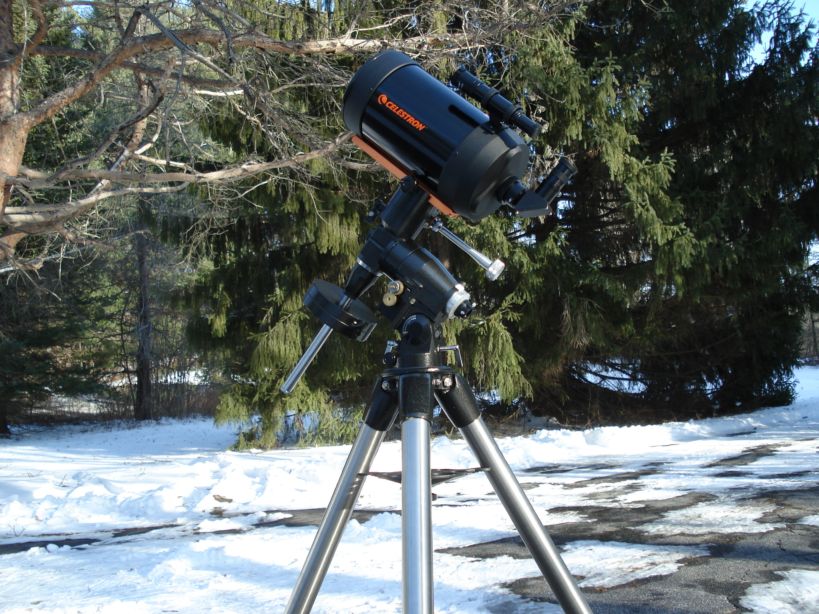
By Ed Ting
Updated 3/4/11, 3/8/11
(6" f/10 Schmidt Cassegrain, OTA, 6X30 finder, dovetail plate, visual back, diagonal, 25 mm E-Lux eyepiece, $600 street + shipping)
(8" f/10 Schmidt-Cassegrain, OTA, 6X30 finder, dovetail plate, visual back, diagonal, 25 mm E-Lux eyepiece, $850 street + shipping)
Believe it or not, this is the first Schmidt-Cassegrain I've ever owned. Not that I've ignored the good 'ol reliable SCT; I've close to buying a C 9.25 at least a couple of times. The only thing that stopped me at the time was that I didn't have a strong enough mount to hold one. I was looking for a compact scope to do a long-term project (which you'll hear about soon, watch this site!) and the C6 fit the bill perfectly. The C6 is the newest member of the Celestron SCT family. It's the first major product from the new Synta-owned Celestron, and the first new size for a Schmidt-Cassegrain in many years (Meade also has a new 6 " SCT.) Like many of Celestron's SCTs, this one is available a number of ways - as a NexStar (about $800), equatorially-mounted on a CG-5 Goto (about $1000), or as an OTA only (about $600.) The NexStar version differs from the others in three ways - The tube is orange instead of black, it has a red dot finder instead of a 6X30 finder, and the Vixen-style dovetail plate is mounted 90 degrees apart from the "normal" location. Otherwise, the tubes are identical.

Celestron's newest SCT- the C6 on a CG5 mount
This is also the first new telescope I've owned in a long time (being a cheapskate, I usually poach off old equipment from local club members.) I ordered the OTA from High Point, and it arrived three days later. First impression - Wow, this thing is tiny! Although it's listed at only 2 lbs lighter than a C8, subjectively it feels much smaller, perhaps about half the size. A CG-4 will hold it comfortably, and a CG-5 will be rock-steady. On the latter, only one 7 lb counterweight is needed, lightening the load even further compared to a C8. (Update: Apparently Celestron's claimed weights are off. My C6 OTA, with 6X30 finder, 1.25" visual back, diagonal, and dovetail plate weighs in at 8.2 lbs. My C8, similarly equipped, weighs in at 12.8 lbs. Thanks to a couple of readers out there who caught this.)
The workmanship appears to be first rate. The corrector plate was squeaky clean and the black paint on the tube was deep and rich. The collimation was very good right out of the box. There was one minor quality control issue with mine: The finder bracket wouldn't align with the main scope. Casual visual inspection didn't reveal anything obvious, but when I moved the finder to the opposite side of the OTA, everything was fine. I'm guessing the holes weren't drilled correctly. I haven't heard of anyone else having this problem, so I'll chalk it up to a bad sample. In any case, right after taking these photos I removed the finder and attached a Rigel Quik Finder. It's stayed in this configuration ever since. The other issue I found was minor - the dust cap was too loose (aren't they all?) I lined the inside of the cap with sticky-backed felt and everything was fine afterwards. Eventually I also ditched the stock visual back in favor of a nice 2" TeleVue unit, and added a dew shield.
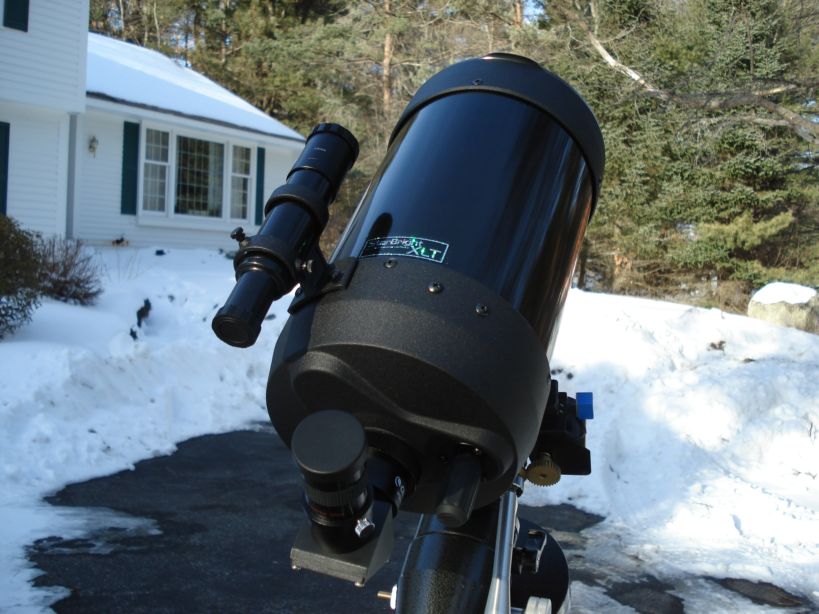
The C6 is remarkably compact compared to a C8
Optically, the scope is good. There's some mild spherical aberration. There's almost no image shift in mine, which is very important if you're doing imaging. I found the focuser's "touch" to be a little on the light side. This is a personal thing, but I like a little resistance in the focuser when I'm using it. I used the scope in the winter of 2010/2011, which has been unusually cold. It sat atop a CG-5 Goto mount. After years of using non-Goto equatorial mounts, I was looking forward to not locking and unlocking those axis levers all night long. Alas, it was not to be, as the CG-5's electronics chose to quit on me the very first night. The mount still tracks, but its alignment system is shot - no matter what time or date you enter, the mount comes back with an odd assortment of random alignment stars, always starting with Deneb (this seems to give fuel to the maxim that if you want your Goto mount to stop working, just sell it to me.)
The scope gives good views of Saturn and Jupiter, and its 1500 mm focal length is optimal for the imaging of these planets. With a 2X barlow, the 3000 mm focal length is just about right under most conditions. Some people worry about the contrast with these SCTs but I didn't notice any issues. M33 was plainly visible, and under good conditions I had little trouble seeing M74. Shadow transits on Jupiter are crisp. On one good night, the views on Jupiter held up at with a 7 mm Nagler. That's good by any standard.
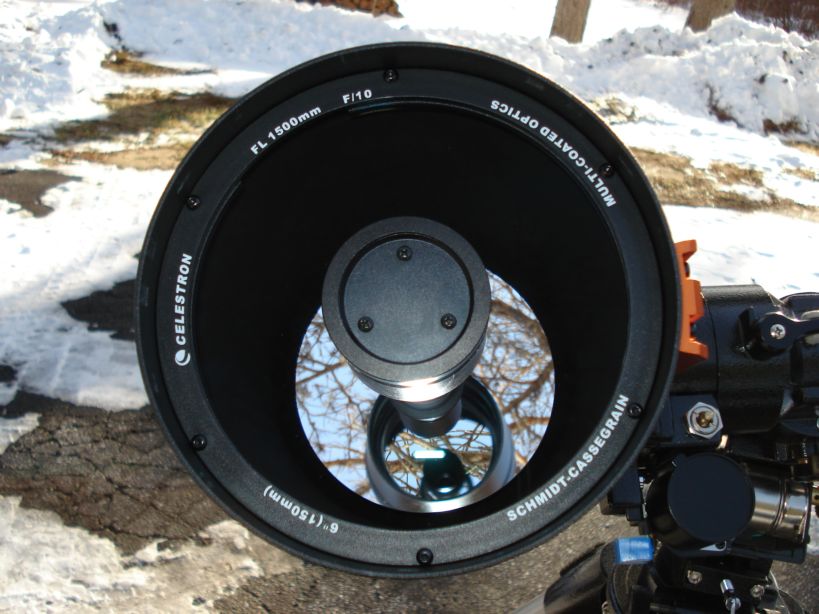
Nice clean corrector plate!
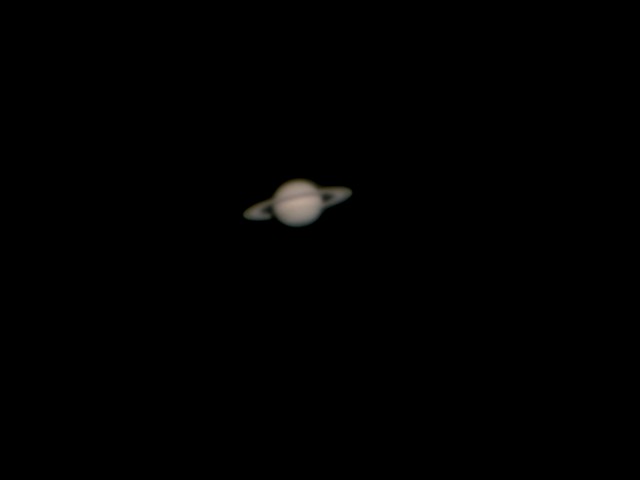
Saturn, 1/16/11 at 5:40 AM
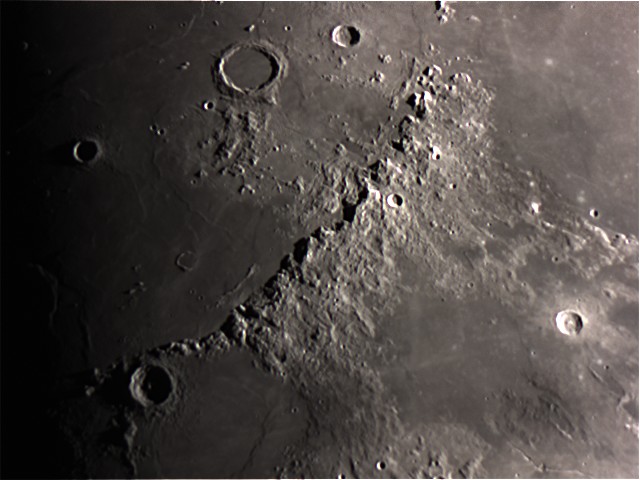
Archimedes and the Alpine Mountains @ prime focus w/ DFK 21AU04.AS camera
I spent some nice nights in January and February 2011 looking at the winter objects. Castor is split at 79X with a 19 mm Panoptic. The winter star clusters in Auriga - M37, M36, and M38 - are nicely framed with the same eyepiece, and NGC 1907 is easily seen next to M38. My favorite unsung winter star cluster is NGC2301, which has several nicknames, but the one I like is "The Klingon Bird of Prey Cluster." Look it up sometime; it's in Monoceros near Procyon.
The supplied 25 mm E-Lux is decent, but you're sure to have other eyepieces of your own. It is rumored that if you use a 2" visual back, the scope will not fully illuminate the field with a very low power 2" eyepiece. However, I used the scope with a 2" diagonal and a 35 mm Panoptic, letting stars drift towards the edge of the field, and never noticed anything.
Celestron's NexStar range is getting a little crowded at the lower end. There's the 4" Mak, a C5 SCT and a C5 Mak, and now this C6. It will be interesting to see if they all remain in the lineup. I'm enough of a geek that I want them all. In the meantime, I'm enjoying my time with the C6. I'm keeping it.
Celestron C6 Hots
Good optics
Compact, light tube
Image scale just right for many types of imaging
Attractive price
Celestron C6 Nots
Finder would not align with main scope
Optics may not be good enough for very picky observers
Verdict
A good general-purpose scope for those who don't like lugging big heavy equipment around
2) Celestron C8 OTA
It took me 30 years to get my first Schmidt-Cassegrain. I had my second one a week later.
There's a story (there's always a story, isn't there?)
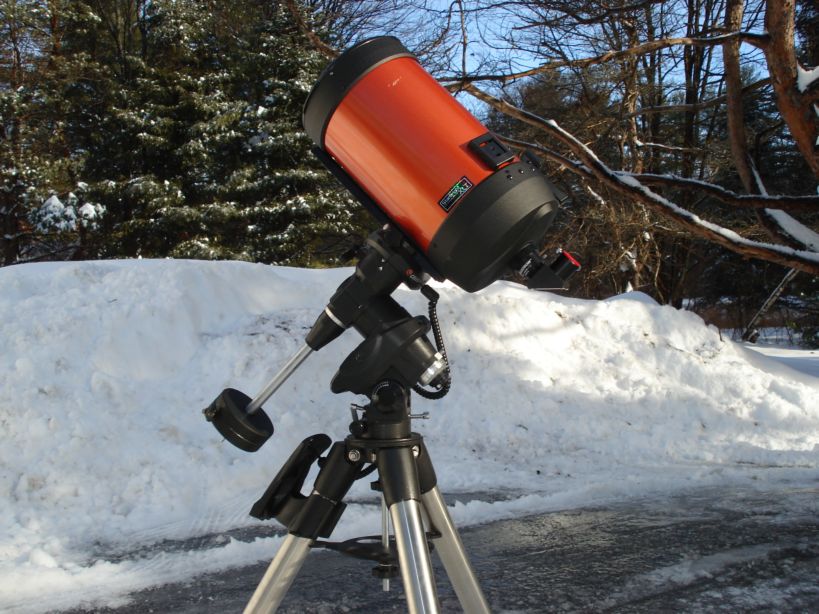
C8 (Orange NexStar version) on a CG-5 Goto mount
A local club member, who shall remain nameless, bought a new NexStar 8. The tube had unusually good optics. He was able to find Triton at 406X and was working his way through the Burnham Project (ie, attempting to see everything listed in Burnham's Celestial Handbook, no small feat.) One night, while bringing the scope into the garage, he set the OTA on top of a plastic garbage can. This was the first and only time he's ever done such a thing. A few seconds later, he heard the crash of metal and glass hitting concrete. The result of the crash wasn't pretty. There are two long cracks in the corrector plate. One reaches radially all the way out from the secondary to the outer edge. The second crack is half the length of the first one. The scope went out of collimation. Amazingly, other than some road rash on the tube, there was no other damage.
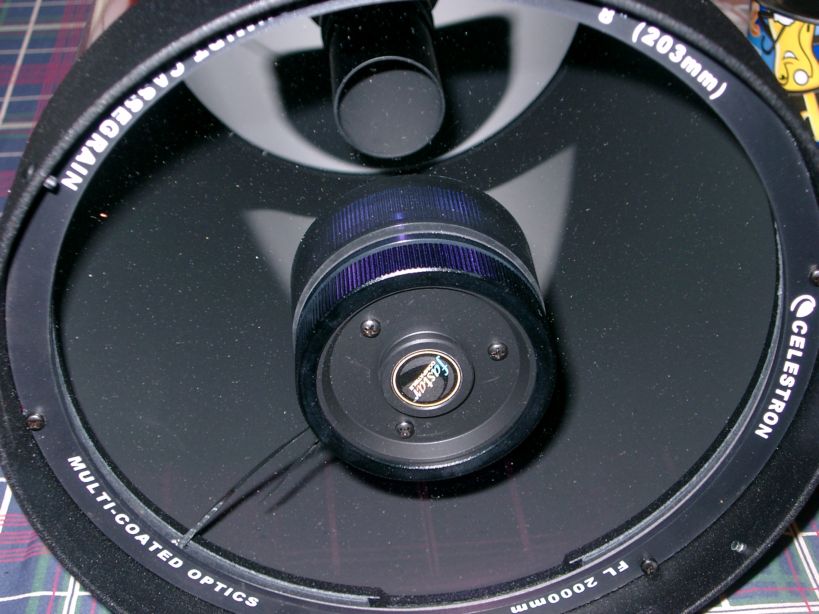
Would you buy this scope?
Refurbishing an SCT telescope with a new corrector plate is a costly repair. The owner didn't even bother contacting Celestron. Instead, he offered it to local club members at a reduced price. I'm not sure what drew me to the scope. I was enjoying the C6 and was wondering what a little more aperture and image scale would do. Also, I have to admit, I felt sorry for the scope. I bought it.
So the question is - how are the optics?
The truth? Pretty darned good. The star test was excellent. I didn't see much, if any spherical aberration. I spent several nights trying to make the scope throw up some artifacts. I looked at the moon, at Jupiter, and at Venus several times. I couldn't see any adverse effects. There's a theory that the crack won't throw up anything immediately obvious, but that it would contribute to an overall softening of the image. It may have the same effect as a single-stalk secondary does on a Newtonian. I tested the scope side by side with the C6 and couldn't see anything unusual. The C8's images were a little bigger and brighter than the C6s (which you'd expect.) I also had no problem seeing M33 and M74. In fact, if I hadn't known about the cracks, I could easily have told you there was nothing unusual about the scope's optics.
Defocused image on the C8. You can see the effect of the crack at 11 o'clock as a general darkening
Other than the obvious defect, the scope looks fine. The optics are very well corrected, even better than on the C6. I was able to catch Uranus in January of 2011 just before it sank into the west. One bonus during that time was that Uranus was very close to Jupiter, sometimes within one degree. The C8 comes with a 1.25" visual back, but the scope just cries out for a 2" back. Also, mine is the orange NexStar version, so it comes with the 1X red dot finder. This finder is WAY TOO BRIGHT. Even at the dimmest setting, the red dot totally obliterates everything in its path. If you observe from dark locations, you're going to want to replace it.
The scope rides well on a CG-5 mount and needs just one 11 lb counterweight. If you've got a Sirius, and Atlas, a GM-8, or a G11, you're going to be in really good shape. There's minor image shift - a little more than on the C6, and just enough to move objects out of the field of view when imaging with a 2X barlow. This was slightly annoying. Also, the dust cap was loose (aren't they all?)
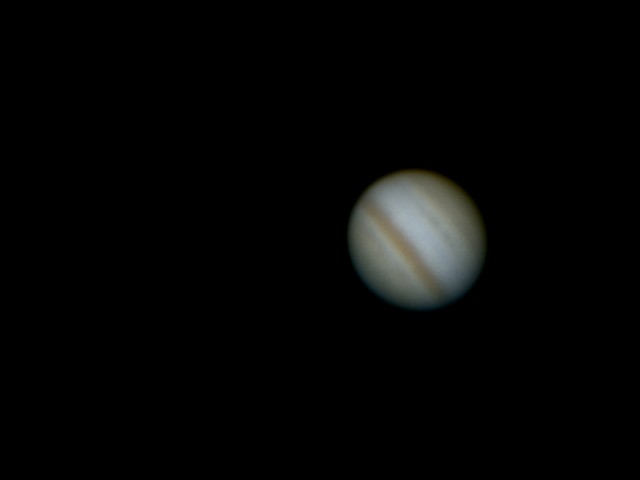
Jupiter through the C8 with a 1.8X barlow and the NexImage
A concern is what effect, if any, time will have on the cracks. Will they one day just expand to the rest of the corrector plate, like the cracks in your windshield in the winter? Who knows? For now I'm not going to worry about it. As far as I'm concerned, I have a C8 with fine optics. In fact, it's become my most used telescope. I'm happy to finally own a C8, one of the most storied and traditional telescopes of all time. For a detailed overview and history of the C8, see my C8 tribute page.
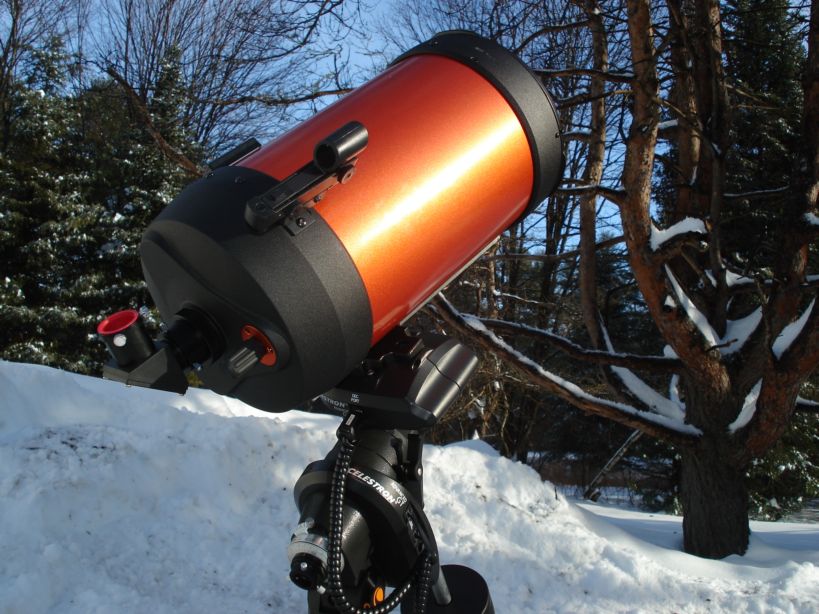
I spent a couple of months observing with both the C6 and the C8, switching off each clear night. If I had to keep only one, which one would it be? As nice as the C6 is, the C8 is just a little bit better. The images are brighter, stars pop out at you more, and dim objects are easier on the eyes. Companion clusters, like NGC 1907 near M38, and NGC 2158 near M35, are easier to see. If I were starting out in this hobby, I'd appreciate the extra aperture that the C8 has to offer. As someone I know who's into high end audio puts it, there's more there there. There's nothing the C6 does that the C8 can't do better except provide a wider field of view, but that's what focal reducers are for. Of course, you know the flaw in this reasoning - everything the C8 does, a C9.25 will do better. And I'd be lying if I said I haven't been checking out ads for used C9.25 OTAs. But hey - you've got to stop somewhere, right? The C8 is the largest Celestron SCT tube that won't stress a CG-5, and I don't feel like getting another mount right now.
Having said this, every time I went back to the C6, I appreciated its compact size, its light weight, and its can-do attitude. It almost doesn't seem right that a scope this small should be able to show you this much. It's the little engine that could. While the C8 is better on absolute terms, the C6 is more consistently good, especially in poor seeing conditions (on more than one evening, when the conditions were really bad, I swapped out the C8 for the C6.) This goes double for the planetary webcam imaging that I've been doing. On bad nights, I could forget about imaging with the C8, but I could count on the C6 to give me at least a few decent results. The opposite is true, however - on really good nights, I made sure the C8 was on the mount. It's a tough call. I love them both, and plan on keeping both, but if I have to have just one, it would be the C8.